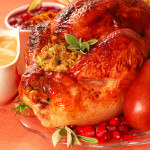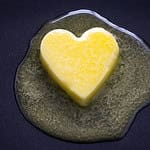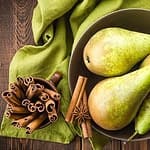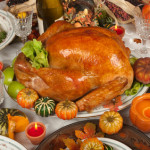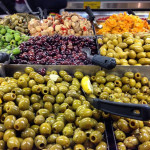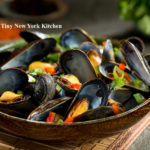Yes, this is an ENTIRE piece on how to thaw a turkey because it’s THE most important part of planning your Thanksgiving menu (if you purchased a frozen turkey that is). Food safety is important so please take a few minutes to review these thawing directions.
1. Make sure to thaw your frozen turkey in the wrapper it came in, UNOPENED.
2. Place it, breast-side up, on a try in the refrigerator.
3. Once thawed, your turkey will keep in the refrigerator for up to 4 days. You should err on the side of thawing a day or two before you’re ready to cook it. This helps prevent any “last minute” thawing issues.
4. If you plan on brining your turkey add an additional thawing day.
5. If you do procrastinate, you can thaw your turkey in cold water. Place the still-wrapped turkey in a container large enough to allow it to be covered with water. Fill the container with cold water and change the water every 30 minutes. This method will thaw a turkey at the rate of about 1 pound every 30 minutes. An 18 pound turkey will take 9 hours to thaw with this method which is why it’s best to plan ahead.
6. NEVER EVER thaw a turkey out on the counter or in warm water. You are creating the perfect environment for bacteria and could end up with a family trip to the emergency room instead of a family weekend of fun!
7. Here is a chart that you can use to determine thawing times.
|
Turkey Size |
Thawing time (In the Refrigerator) |
|
8-12 lb. |
2-3 days |
|
12-14 lb. |
3-3½ days |
|
14-18 lb. |
3½-4½ days |
|
18-20 lb. |
4½-5 days |
"Work With What You Got!"
© Victoria Hart Glavin Tiny New York Kitchen
For those who love it, cooking is at once child's play and adult joy. – Craig Claiborne
The secret of change is to focus all of your energy, not on fighting the old, but on building the new. – Socrates
Homemade is alright with me. Homemade is the way it should be.
No one gets a lot until everyone gets some. – Sister Marion
I just ordered my Thanksgiving turkey, which I like to get done early, as it truly is the star of Thanksgiving dinner. When planning your holiday menu purchasing a turkey is the first thing to consider. Should you buy fresh or frozen? Below is a breakdown of turkey buying options.
Fresh Turkey
Purchasing a fresh turkey is my first choice by far. Fresh turkeys often need to be ordered in advance because not all markets carry them. They tend to be more expensive than frozen turkeys because they have a short shelf life. Because they should only be kept in your refrigerator for about 2 days before roasting, you will need to plan carefully.
Kosher Turkey
Many chefs and home cooks like buying kosher turkeys. Making a turkey kosher involves soaking it in a salt brine. Kosher turkeys give you the flavor, tenderness, and juiciness of brining without requiring the time it takes to brine in your own kitchen. If you use a kosher turkey, be sure to omit any salt that may be in the recipe or it will taste way too salty.
Free-Range Turkey
Free range means that the turkey has been raised in a facility that allows the birds to have access to the outdoors and a yard to walk around in. Free-Range turkeys can be either fresh or frozen. This does not, however, imply organic.
Organic Turkey
For poultry to be labeled organic, it must be fed organic grains its entire life, never receive antibiotics or hormones (no poultry is allowed to receive hormones in the United States) and must have access to the outdoors. Like free-range turkeys, they can be purchased either fresh or frozen.
Prebasted Turkey
Prebasting is a process that adds moisture to a turkey in the form of broth and flavorings under the skin. Turkey experts agree that there is no need to baste a turkey, whether it is prebasted or not. The liquid you pour over a cooking turkey doesn’t actually make the turkey juicier, and opening the oven door to baste just means that the turkey will take longer to cook due to losing heat every time the oven door is opened.
"Work With What You Got!"
© Victoria Hart Glavin Tiny New York Kitchen
In Remembrance Of Those Who Protect Us!
Happiness is not something you postpone for the future, it is something you design for the present.
Wine Is Just Happiness Borrowed From Tomorrow


